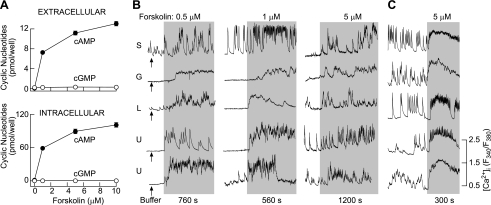Fig. 1.
Concentration-dependent effect of forskolin on cyclic nucleotide production and calcium signaling in normal (A and B) and GH3 immortalized (C) rat anterior pituitary cells. A: forskolin-stimulated cAMP and 3′,5′-cyclic monophosphate (cGMP) intracellular accumulation and release in cells with inhibited phosphodiesterases in the presence of 1 mM isobutylmethylxanthine. Cells were stimulated for 30 min at 37°C. Data shown are means ± SE from 6 determinations. B: forskolin-stimulated calcium transients in pituitary cells. The addition of medium was used as a control (arrows at left). C: forskolin-stimulated calcium influx in GH3 cells. In B and C, traces shown are representative for 5–7 experiments with ≥15 single-cell recordings/experiment. Gray areas indicate the duration of forskolin stimulation. S, somatotrophs; G, gonadotrophs; L, lactotrophs; U, unidentified cells. Cells were identified as described in materials and methods.

